Recruitment and Selection Strategies: A Business Report for ALDI
VerifiedAdded on 2020/06/04
|10
|2707
|122
Report
AI Summary
This report provides a comprehensive overview of recruitment and selection processes within a business context, using ALDI as a case study. It begins by exploring internal and external recruitment sources, followed by an analysis of the legal and regulatory framework impacting recruitment and selection activities, including the Minimum Wage Act, Equality Act 2010, and Health and Safety at Work Act 1974. The report then delves into the creation of job descriptions and specifications for sales assistants, outlining their daily duties and required personal skills. Finally, it examines the selection interview process, detailing the stages involved, from initial screening to job offers, along with the roles and responsibilities of interviewers in evaluating candidates and presenting the company. The report emphasizes the importance of a structured approach to recruitment and selection to secure talented workforce.
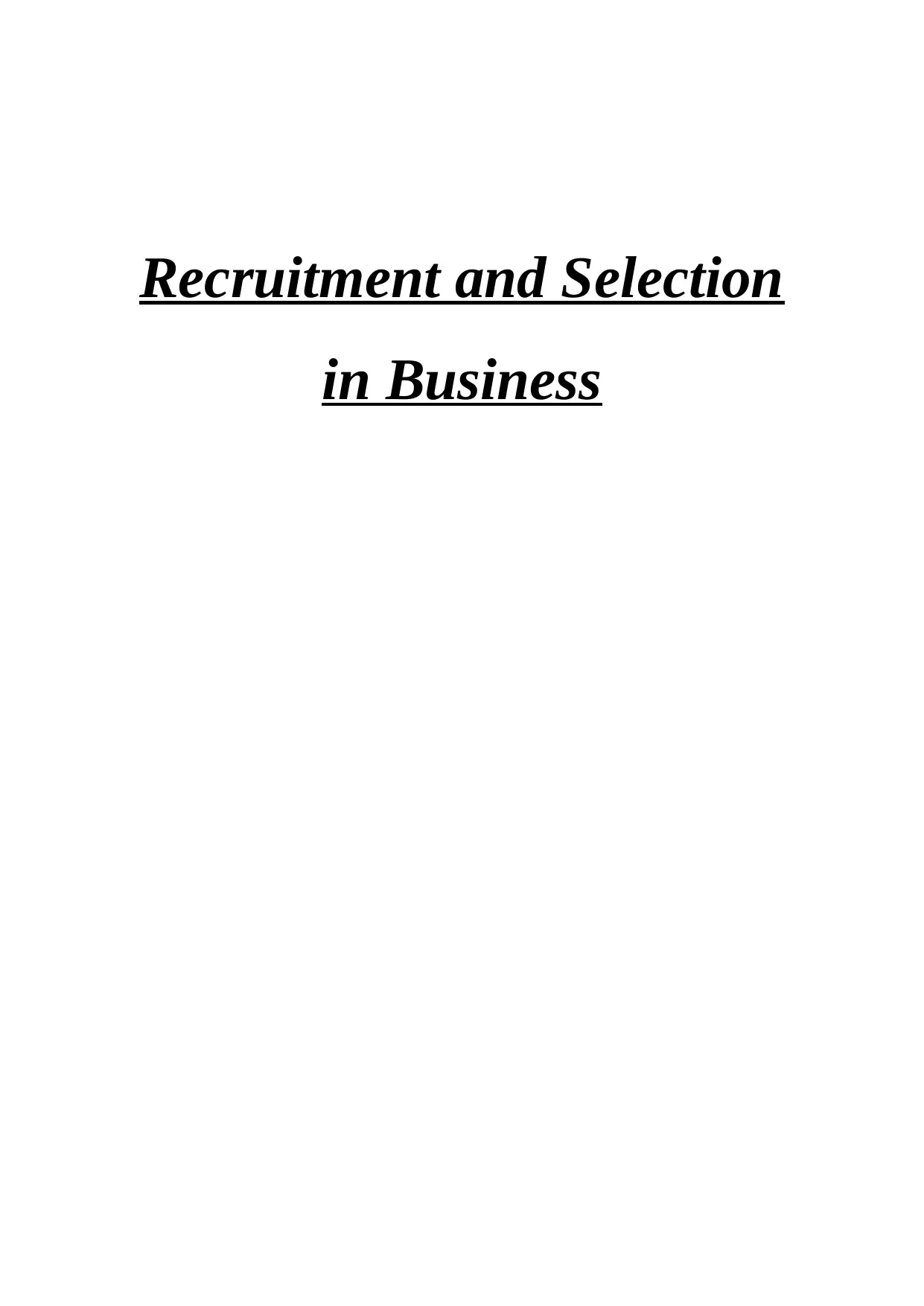
Recruitment and Selection
in Business
in Business
Paraphrase This Document
Need a fresh take? Get an instant paraphrase of this document with our AI Paraphraser
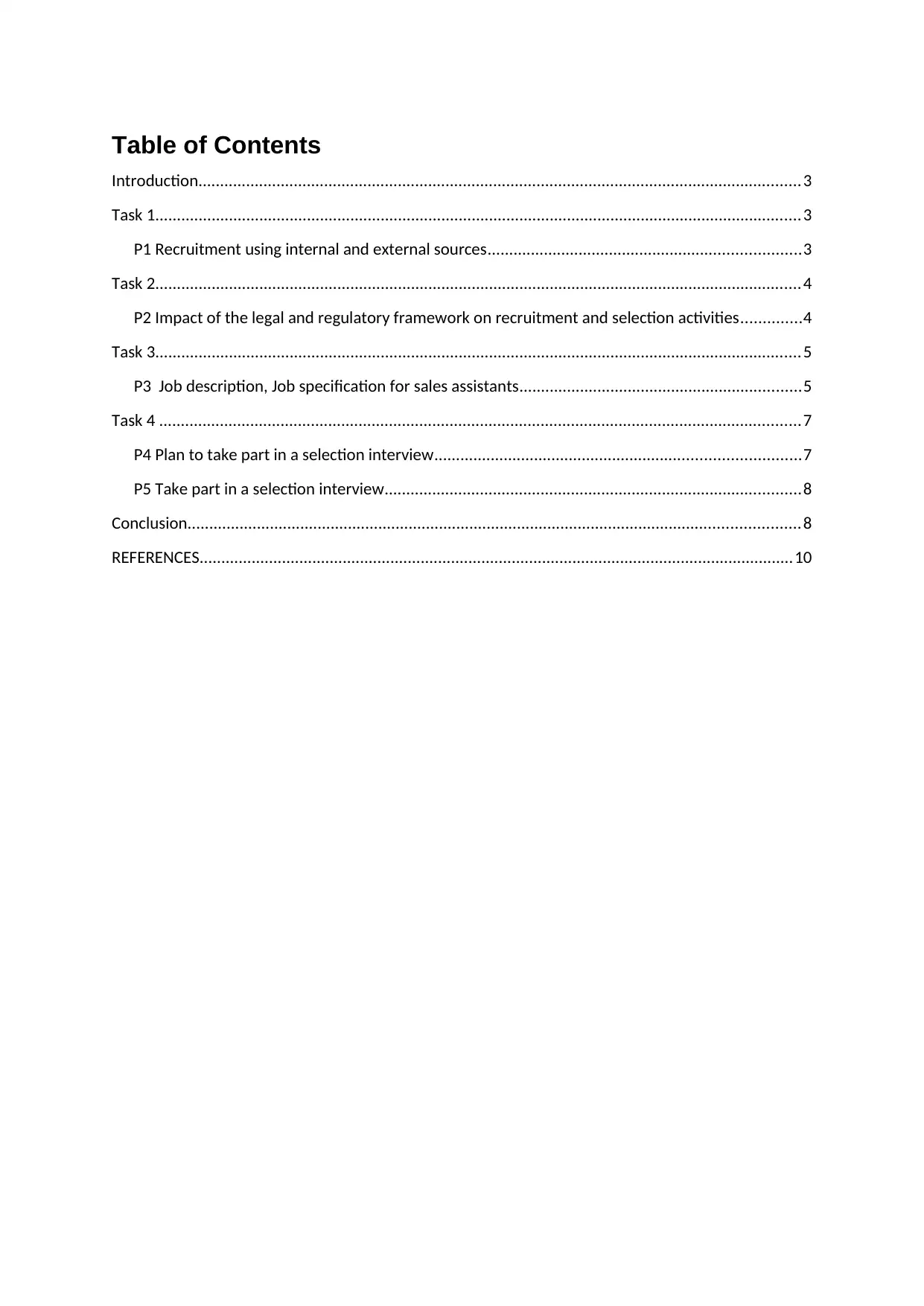
Table of Contents
Introduction...........................................................................................................................................3
Task 1.....................................................................................................................................................3
P1 Recruitment using internal and external sources........................................................................3
Task 2.....................................................................................................................................................4
P2 Impact of the legal and regulatory framework on recruitment and selection activities..............4
Task 3.....................................................................................................................................................5
P3 Job description, Job specification for sales assistants.................................................................5
Task 4 ....................................................................................................................................................7
P4 Plan to take part in a selection interview....................................................................................7
P5 Take part in a selection interview................................................................................................8
Conclusion.............................................................................................................................................8
REFERENCES.........................................................................................................................................10
Introduction...........................................................................................................................................3
Task 1.....................................................................................................................................................3
P1 Recruitment using internal and external sources........................................................................3
Task 2.....................................................................................................................................................4
P2 Impact of the legal and regulatory framework on recruitment and selection activities..............4
Task 3.....................................................................................................................................................5
P3 Job description, Job specification for sales assistants.................................................................5
Task 4 ....................................................................................................................................................7
P4 Plan to take part in a selection interview....................................................................................7
P5 Take part in a selection interview................................................................................................8
Conclusion.............................................................................................................................................8
REFERENCES.........................................................................................................................................10
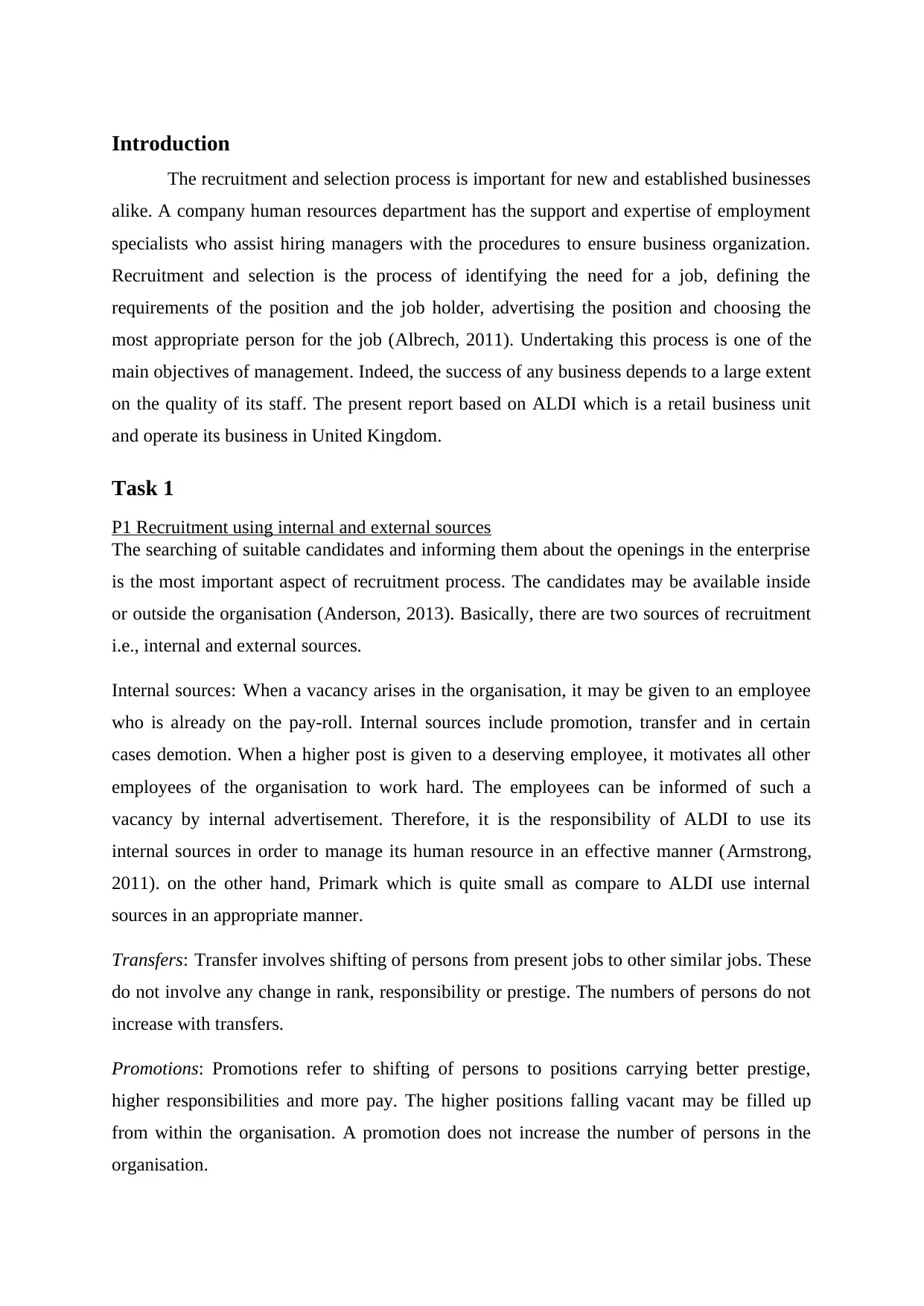
Introduction
The recruitment and selection process is important for new and established businesses
alike. A company human resources department has the support and expertise of employment
specialists who assist hiring managers with the procedures to ensure business organization.
Recruitment and selection is the process of identifying the need for a job, defining the
requirements of the position and the job holder, advertising the position and choosing the
most appropriate person for the job (Albrech, 2011). Undertaking this process is one of the
main objectives of management. Indeed, the success of any business depends to a large extent
on the quality of its staff. The present report based on ALDI which is a retail business unit
and operate its business in United Kingdom.
Task 1
P1 Recruitment using internal and external sources
The searching of suitable candidates and informing them about the openings in the enterprise
is the most important aspect of recruitment process. The candidates may be available inside
or outside the organisation (Anderson, 2013). Basically, there are two sources of recruitment
i.e., internal and external sources.
Internal sources: When a vacancy arises in the organisation, it may be given to an employee
who is already on the pay-roll. Internal sources include promotion, transfer and in certain
cases demotion. When a higher post is given to a deserving employee, it motivates all other
employees of the organisation to work hard. The employees can be informed of such a
vacancy by internal advertisement. Therefore, it is the responsibility of ALDI to use its
internal sources in order to manage its human resource in an effective manner (Armstrong,
2011). on the other hand, Primark which is quite small as compare to ALDI use internal
sources in an appropriate manner.
Transfers: Transfer involves shifting of persons from present jobs to other similar jobs. These
do not involve any change in rank, responsibility or prestige. The numbers of persons do not
increase with transfers.
Promotions: Promotions refer to shifting of persons to positions carrying better prestige,
higher responsibilities and more pay. The higher positions falling vacant may be filled up
from within the organisation. A promotion does not increase the number of persons in the
organisation.
The recruitment and selection process is important for new and established businesses
alike. A company human resources department has the support and expertise of employment
specialists who assist hiring managers with the procedures to ensure business organization.
Recruitment and selection is the process of identifying the need for a job, defining the
requirements of the position and the job holder, advertising the position and choosing the
most appropriate person for the job (Albrech, 2011). Undertaking this process is one of the
main objectives of management. Indeed, the success of any business depends to a large extent
on the quality of its staff. The present report based on ALDI which is a retail business unit
and operate its business in United Kingdom.
Task 1
P1 Recruitment using internal and external sources
The searching of suitable candidates and informing them about the openings in the enterprise
is the most important aspect of recruitment process. The candidates may be available inside
or outside the organisation (Anderson, 2013). Basically, there are two sources of recruitment
i.e., internal and external sources.
Internal sources: When a vacancy arises in the organisation, it may be given to an employee
who is already on the pay-roll. Internal sources include promotion, transfer and in certain
cases demotion. When a higher post is given to a deserving employee, it motivates all other
employees of the organisation to work hard. The employees can be informed of such a
vacancy by internal advertisement. Therefore, it is the responsibility of ALDI to use its
internal sources in order to manage its human resource in an effective manner (Armstrong,
2011). on the other hand, Primark which is quite small as compare to ALDI use internal
sources in an appropriate manner.
Transfers: Transfer involves shifting of persons from present jobs to other similar jobs. These
do not involve any change in rank, responsibility or prestige. The numbers of persons do not
increase with transfers.
Promotions: Promotions refer to shifting of persons to positions carrying better prestige,
higher responsibilities and more pay. The higher positions falling vacant may be filled up
from within the organisation. A promotion does not increase the number of persons in the
organisation.
⊘ This is a preview!⊘
Do you want full access?
Subscribe today to unlock all pages.

Trusted by 1+ million students worldwide
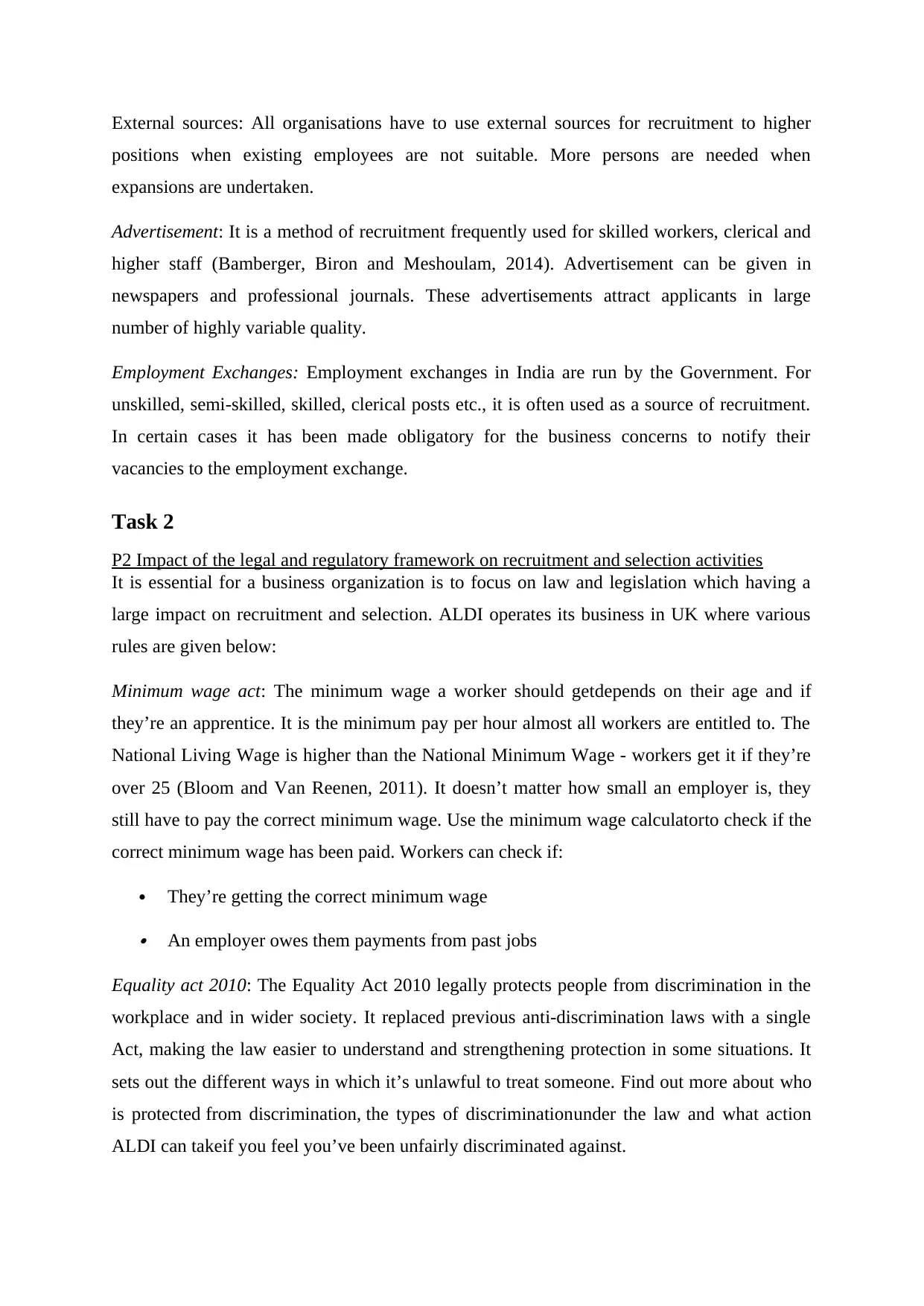
External sources: All organisations have to use external sources for recruitment to higher
positions when existing employees are not suitable. More persons are needed when
expansions are undertaken.
Advertisement: It is a method of recruitment frequently used for skilled workers, clerical and
higher staff (Bamberger, Biron and Meshoulam, 2014). Advertisement can be given in
newspapers and professional journals. These advertisements attract applicants in large
number of highly variable quality.
Employment Exchanges: Employment exchanges in India are run by the Government. For
unskilled, semi-skilled, skilled, clerical posts etc., it is often used as a source of recruitment.
In certain cases it has been made obligatory for the business concerns to notify their
vacancies to the employment exchange.
Task 2
P2 Impact of the legal and regulatory framework on recruitment and selection activities
It is essential for a business organization is to focus on law and legislation which having a
large impact on recruitment and selection. ALDI operates its business in UK where various
rules are given below:
Minimum wage act: The minimum wage a worker should getdepends on their age and if
they’re an apprentice. It is the minimum pay per hour almost all workers are entitled to. The
National Living Wage is higher than the National Minimum Wage - workers get it if they’re
over 25 (Bloom and Van Reenen, 2011). It doesn’t matter how small an employer is, they
still have to pay the correct minimum wage. Use the minimum wage calculatorto check if the
correct minimum wage has been paid. Workers can check if:
They’re getting the correct minimum wage An employer owes them payments from past jobs
Equality act 2010: The Equality Act 2010 legally protects people from discrimination in the
workplace and in wider society. It replaced previous anti-discrimination laws with a single
Act, making the law easier to understand and strengthening protection in some situations. It
sets out the different ways in which it’s unlawful to treat someone. Find out more about who
is protected from discrimination, the types of discriminationunder the law and what action
ALDI can takeif you feel you’ve been unfairly discriminated against.
positions when existing employees are not suitable. More persons are needed when
expansions are undertaken.
Advertisement: It is a method of recruitment frequently used for skilled workers, clerical and
higher staff (Bamberger, Biron and Meshoulam, 2014). Advertisement can be given in
newspapers and professional journals. These advertisements attract applicants in large
number of highly variable quality.
Employment Exchanges: Employment exchanges in India are run by the Government. For
unskilled, semi-skilled, skilled, clerical posts etc., it is often used as a source of recruitment.
In certain cases it has been made obligatory for the business concerns to notify their
vacancies to the employment exchange.
Task 2
P2 Impact of the legal and regulatory framework on recruitment and selection activities
It is essential for a business organization is to focus on law and legislation which having a
large impact on recruitment and selection. ALDI operates its business in UK where various
rules are given below:
Minimum wage act: The minimum wage a worker should getdepends on their age and if
they’re an apprentice. It is the minimum pay per hour almost all workers are entitled to. The
National Living Wage is higher than the National Minimum Wage - workers get it if they’re
over 25 (Bloom and Van Reenen, 2011). It doesn’t matter how small an employer is, they
still have to pay the correct minimum wage. Use the minimum wage calculatorto check if the
correct minimum wage has been paid. Workers can check if:
They’re getting the correct minimum wage An employer owes them payments from past jobs
Equality act 2010: The Equality Act 2010 legally protects people from discrimination in the
workplace and in wider society. It replaced previous anti-discrimination laws with a single
Act, making the law easier to understand and strengthening protection in some situations. It
sets out the different ways in which it’s unlawful to treat someone. Find out more about who
is protected from discrimination, the types of discriminationunder the law and what action
ALDI can takeif you feel you’ve been unfairly discriminated against.
Paraphrase This Document
Need a fresh take? Get an instant paraphrase of this document with our AI Paraphraser
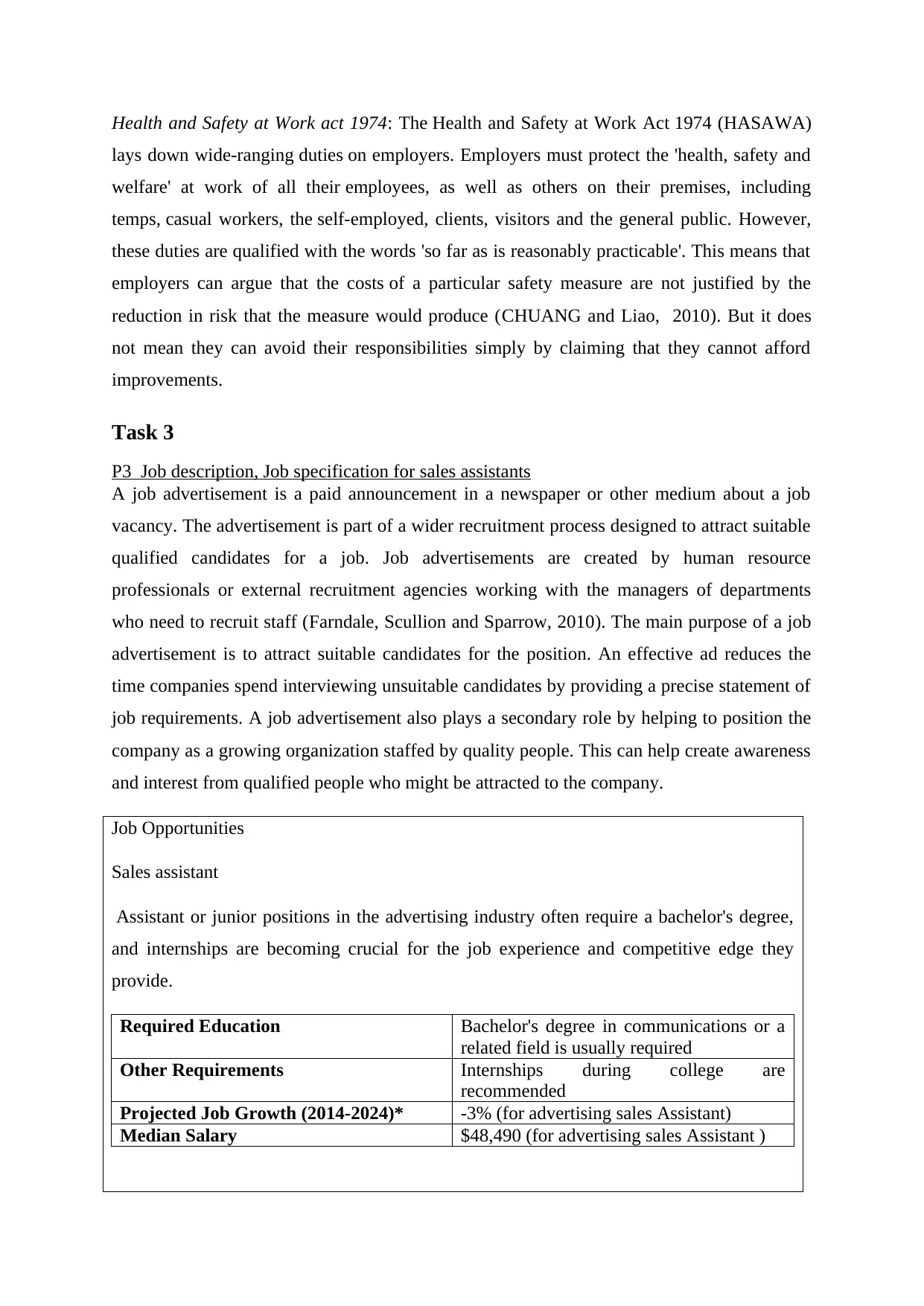
Health and Safety at Work act 1974: The Health and Safety at Work Act 1974 (HASAWA)
lays down wide-ranging duties on employers. Employers must protect the 'health, safety and
welfare' at work of all their employees, as well as others on their premises, including
temps, casual workers, the self-employed, clients, visitors and the general public. However,
these duties are qualified with the words 'so far as is reasonably practicable'. This means that
employers can argue that the costs of a particular safety measure are not justified by the
reduction in risk that the measure would produce (CHUANG and Liao, 2010). But it does
not mean they can avoid their responsibilities simply by claiming that they cannot afford
improvements.
Task 3
P3 Job description, Job specification for sales assistants
A job advertisement is a paid announcement in a newspaper or other medium about a job
vacancy. The advertisement is part of a wider recruitment process designed to attract suitable
qualified candidates for a job. Job advertisements are created by human resource
professionals or external recruitment agencies working with the managers of departments
who need to recruit staff (Farndale, Scullion and Sparrow, 2010). The main purpose of a job
advertisement is to attract suitable candidates for the position. An effective ad reduces the
time companies spend interviewing unsuitable candidates by providing a precise statement of
job requirements. A job advertisement also plays a secondary role by helping to position the
company as a growing organization staffed by quality people. This can help create awareness
and interest from qualified people who might be attracted to the company.
Job Opportunities
Sales assistant
Assistant or junior positions in the advertising industry often require a bachelor's degree,
and internships are becoming crucial for the job experience and competitive edge they
provide.
Required Education Bachelor's degree in communications or a
related field is usually required
Other Requirements Internships during college are
recommended
Projected Job Growth (2014-2024)* -3% (for advertising sales Assistant)
Median Salary $48,490 (for advertising sales Assistant )
lays down wide-ranging duties on employers. Employers must protect the 'health, safety and
welfare' at work of all their employees, as well as others on their premises, including
temps, casual workers, the self-employed, clients, visitors and the general public. However,
these duties are qualified with the words 'so far as is reasonably practicable'. This means that
employers can argue that the costs of a particular safety measure are not justified by the
reduction in risk that the measure would produce (CHUANG and Liao, 2010). But it does
not mean they can avoid their responsibilities simply by claiming that they cannot afford
improvements.
Task 3
P3 Job description, Job specification for sales assistants
A job advertisement is a paid announcement in a newspaper or other medium about a job
vacancy. The advertisement is part of a wider recruitment process designed to attract suitable
qualified candidates for a job. Job advertisements are created by human resource
professionals or external recruitment agencies working with the managers of departments
who need to recruit staff (Farndale, Scullion and Sparrow, 2010). The main purpose of a job
advertisement is to attract suitable candidates for the position. An effective ad reduces the
time companies spend interviewing unsuitable candidates by providing a precise statement of
job requirements. A job advertisement also plays a secondary role by helping to position the
company as a growing organization staffed by quality people. This can help create awareness
and interest from qualified people who might be attracted to the company.
Job Opportunities
Sales assistant
Assistant or junior positions in the advertising industry often require a bachelor's degree,
and internships are becoming crucial for the job experience and competitive edge they
provide.
Required Education Bachelor's degree in communications or a
related field is usually required
Other Requirements Internships during college are
recommended
Projected Job Growth (2014-2024)* -3% (for advertising sales Assistant)
Median Salary $48,490 (for advertising sales Assistant )
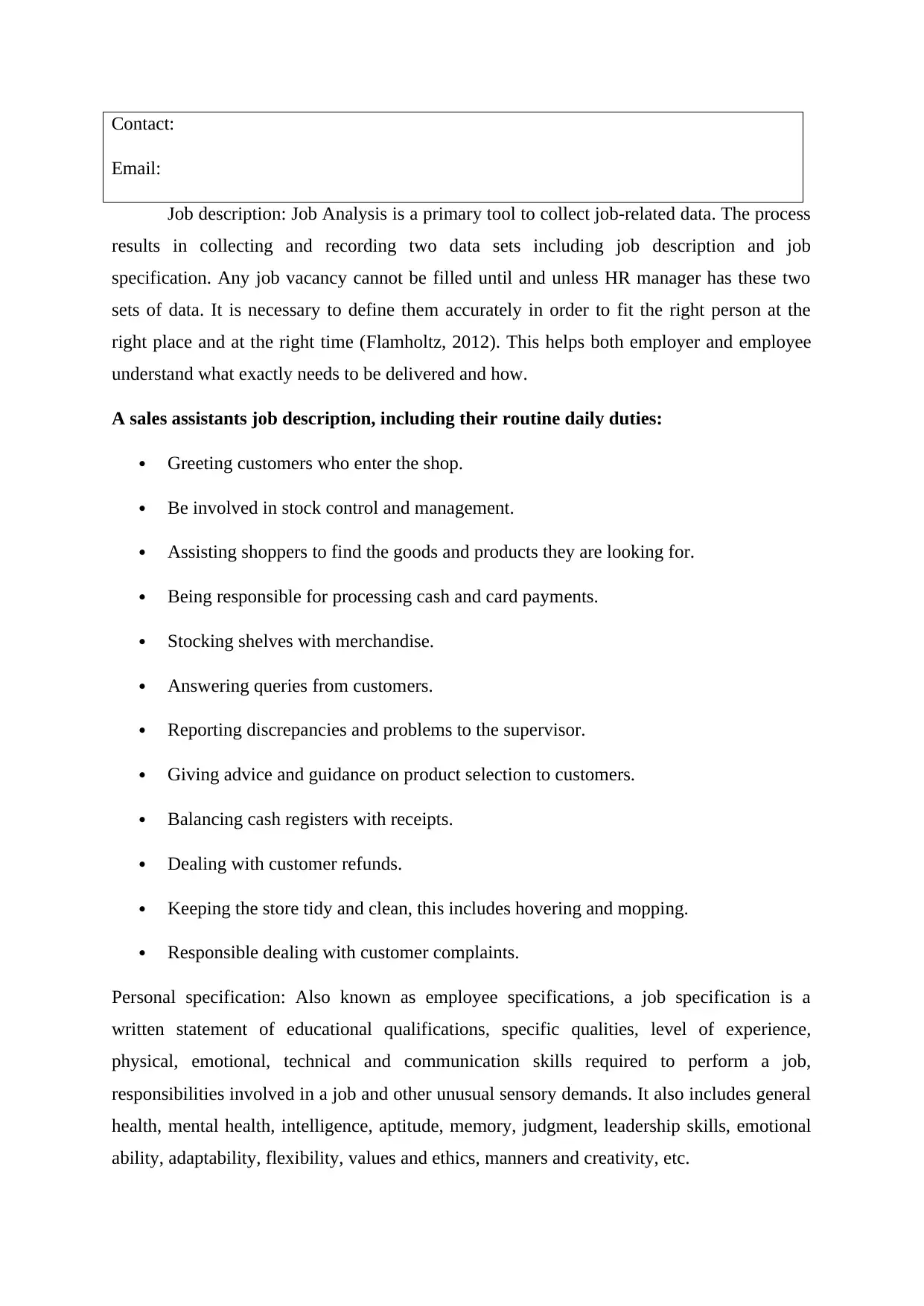
Contact:
Email:
Job description: Job Analysis is a primary tool to collect job-related data. The process
results in collecting and recording two data sets including job description and job
specification. Any job vacancy cannot be filled until and unless HR manager has these two
sets of data. It is necessary to define them accurately in order to fit the right person at the
right place and at the right time (Flamholtz, 2012). This helps both employer and employee
understand what exactly needs to be delivered and how.
A sales assistants job description, including their routine daily duties:
Greeting customers who enter the shop.
Be involved in stock control and management.
Assisting shoppers to find the goods and products they are looking for.
Being responsible for processing cash and card payments.
Stocking shelves with merchandise.
Answering queries from customers.
Reporting discrepancies and problems to the supervisor.
Giving advice and guidance on product selection to customers.
Balancing cash registers with receipts.
Dealing with customer refunds.
Keeping the store tidy and clean, this includes hovering and mopping.
Responsible dealing with customer complaints.
Personal specification: Also known as employee specifications, a job specification is a
written statement of educational qualifications, specific qualities, level of experience,
physical, emotional, technical and communication skills required to perform a job,
responsibilities involved in a job and other unusual sensory demands. It also includes general
health, mental health, intelligence, aptitude, memory, judgment, leadership skills, emotional
ability, adaptability, flexibility, values and ethics, manners and creativity, etc.
Email:
Job description: Job Analysis is a primary tool to collect job-related data. The process
results in collecting and recording two data sets including job description and job
specification. Any job vacancy cannot be filled until and unless HR manager has these two
sets of data. It is necessary to define them accurately in order to fit the right person at the
right place and at the right time (Flamholtz, 2012). This helps both employer and employee
understand what exactly needs to be delivered and how.
A sales assistants job description, including their routine daily duties:
Greeting customers who enter the shop.
Be involved in stock control and management.
Assisting shoppers to find the goods and products they are looking for.
Being responsible for processing cash and card payments.
Stocking shelves with merchandise.
Answering queries from customers.
Reporting discrepancies and problems to the supervisor.
Giving advice and guidance on product selection to customers.
Balancing cash registers with receipts.
Dealing with customer refunds.
Keeping the store tidy and clean, this includes hovering and mopping.
Responsible dealing with customer complaints.
Personal specification: Also known as employee specifications, a job specification is a
written statement of educational qualifications, specific qualities, level of experience,
physical, emotional, technical and communication skills required to perform a job,
responsibilities involved in a job and other unusual sensory demands. It also includes general
health, mental health, intelligence, aptitude, memory, judgment, leadership skills, emotional
ability, adaptability, flexibility, values and ethics, manners and creativity, etc.
⊘ This is a preview!⊘
Do you want full access?
Subscribe today to unlock all pages.

Trusted by 1+ million students worldwide
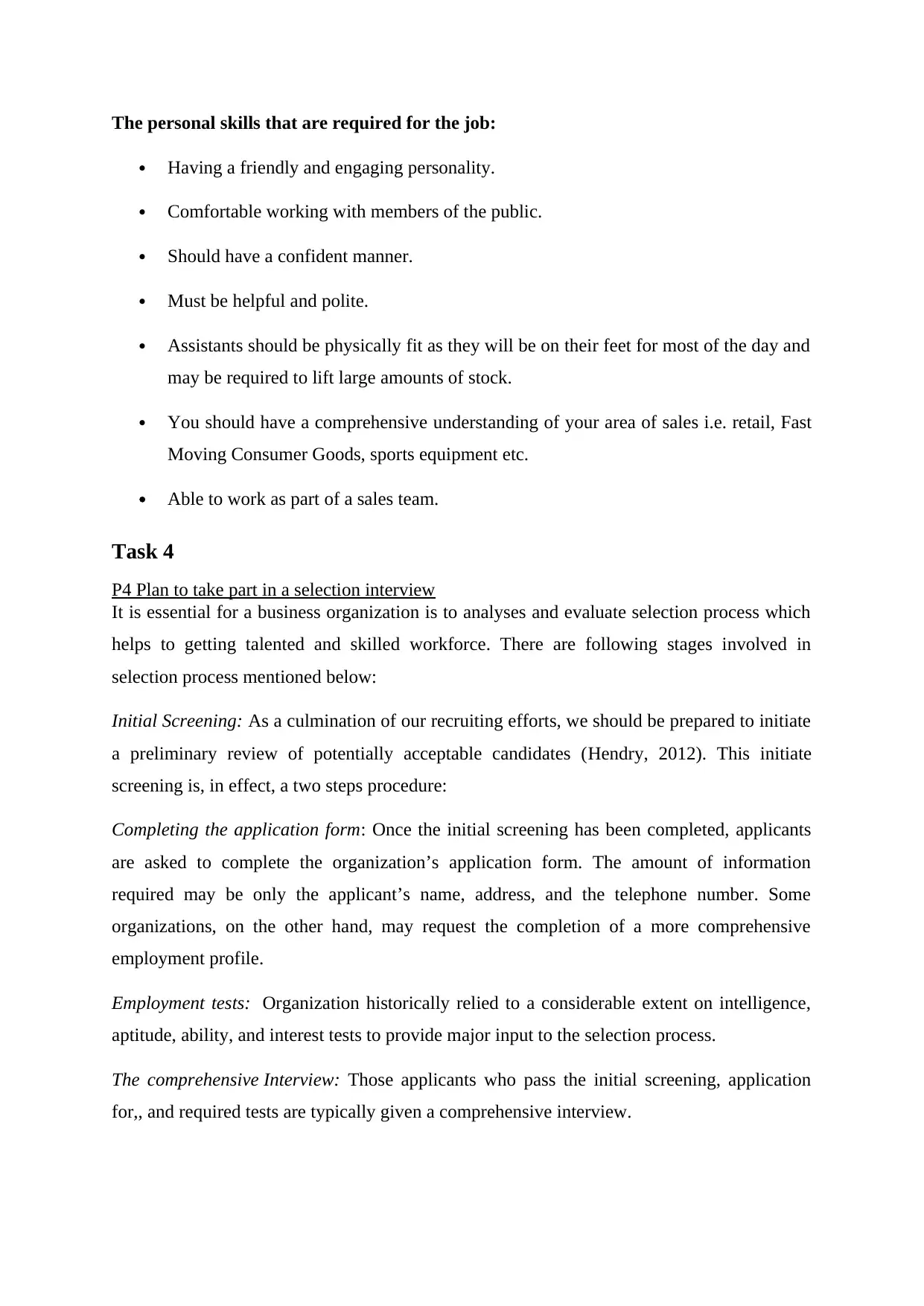
The personal skills that are required for the job:
Having a friendly and engaging personality.
Comfortable working with members of the public.
Should have a confident manner.
Must be helpful and polite.
Assistants should be physically fit as they will be on their feet for most of the day and
may be required to lift large amounts of stock.
You should have a comprehensive understanding of your area of sales i.e. retail, Fast
Moving Consumer Goods, sports equipment etc.
Able to work as part of a sales team.
Task 4
P4 Plan to take part in a selection interview
It is essential for a business organization is to analyses and evaluate selection process which
helps to getting talented and skilled workforce. There are following stages involved in
selection process mentioned below:
Initial Screening: As a culmination of our recruiting efforts, we should be prepared to initiate
a preliminary review of potentially acceptable candidates (Hendry, 2012). This initiate
screening is, in effect, a two steps procedure:
Completing the application form: Once the initial screening has been completed, applicants
are asked to complete the organization’s application form. The amount of information
required may be only the applicant’s name, address, and the telephone number. Some
organizations, on the other hand, may request the completion of a more comprehensive
employment profile.
Employment tests: Organization historically relied to a considerable extent on intelligence,
aptitude, ability, and interest tests to provide major input to the selection process.
The comprehensive Interview: Those applicants who pass the initial screening, application
for,, and required tests are typically given a comprehensive interview.
Having a friendly and engaging personality.
Comfortable working with members of the public.
Should have a confident manner.
Must be helpful and polite.
Assistants should be physically fit as they will be on their feet for most of the day and
may be required to lift large amounts of stock.
You should have a comprehensive understanding of your area of sales i.e. retail, Fast
Moving Consumer Goods, sports equipment etc.
Able to work as part of a sales team.
Task 4
P4 Plan to take part in a selection interview
It is essential for a business organization is to analyses and evaluate selection process which
helps to getting talented and skilled workforce. There are following stages involved in
selection process mentioned below:
Initial Screening: As a culmination of our recruiting efforts, we should be prepared to initiate
a preliminary review of potentially acceptable candidates (Hendry, 2012). This initiate
screening is, in effect, a two steps procedure:
Completing the application form: Once the initial screening has been completed, applicants
are asked to complete the organization’s application form. The amount of information
required may be only the applicant’s name, address, and the telephone number. Some
organizations, on the other hand, may request the completion of a more comprehensive
employment profile.
Employment tests: Organization historically relied to a considerable extent on intelligence,
aptitude, ability, and interest tests to provide major input to the selection process.
The comprehensive Interview: Those applicants who pass the initial screening, application
for,, and required tests are typically given a comprehensive interview.
Paraphrase This Document
Need a fresh take? Get an instant paraphrase of this document with our AI Paraphraser
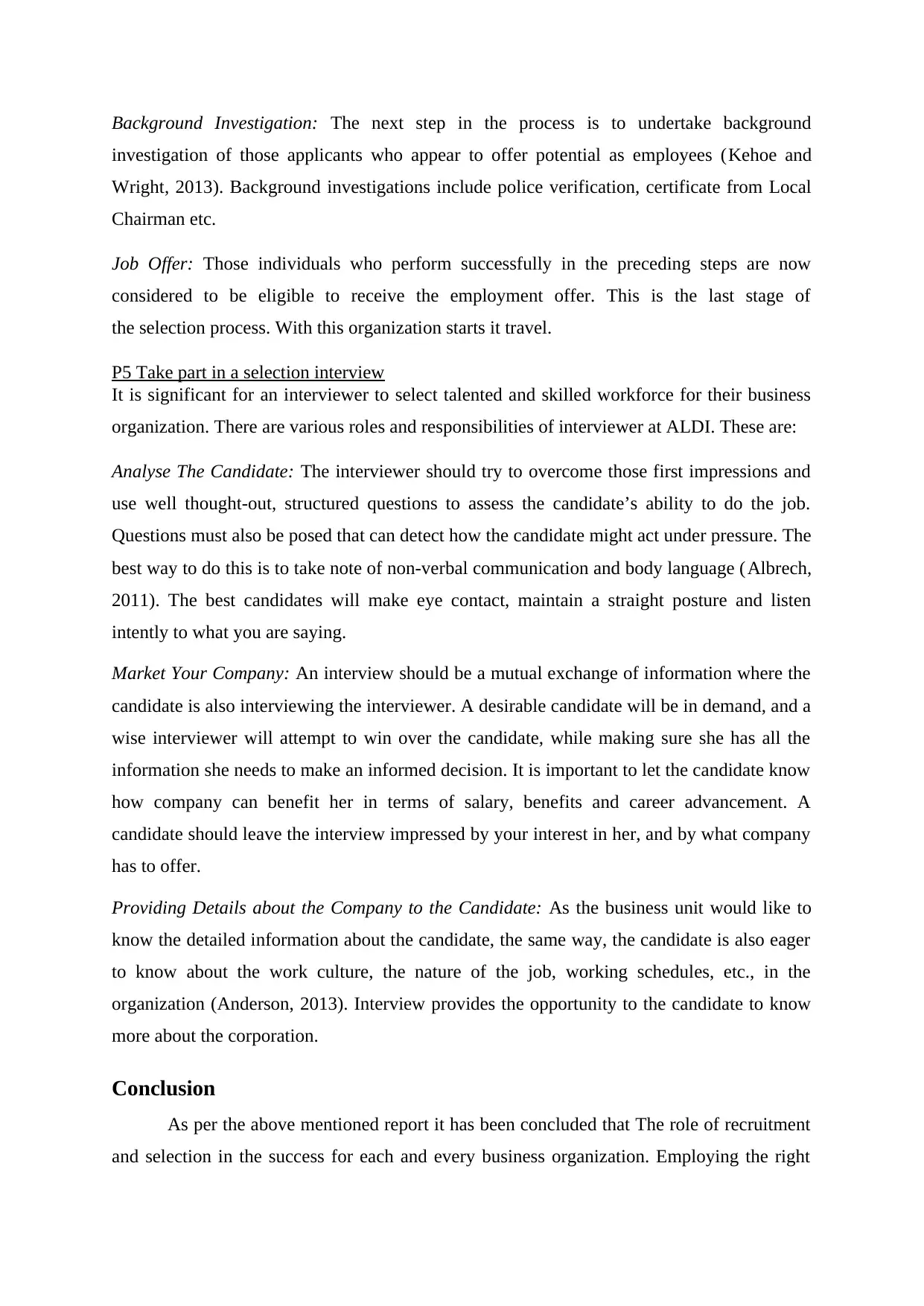
Background Investigation: The next step in the process is to undertake background
investigation of those applicants who appear to offer potential as employees (Kehoe and
Wright, 2013). Background investigations include police verification, certificate from Local
Chairman etc.
Job Offer: Those individuals who perform successfully in the preceding steps are now
considered to be eligible to receive the employment offer. This is the last stage of
the selection process. With this organization starts it travel.
P5 Take part in a selection interview
It is significant for an interviewer to select talented and skilled workforce for their business
organization. There are various roles and responsibilities of interviewer at ALDI. These are:
Analyse The Candidate: The interviewer should try to overcome those first impressions and
use well thought-out, structured questions to assess the candidate’s ability to do the job.
Questions must also be posed that can detect how the candidate might act under pressure. The
best way to do this is to take note of non-verbal communication and body language (Albrech,
2011). The best candidates will make eye contact, maintain a straight posture and listen
intently to what you are saying.
Market Your Company: An interview should be a mutual exchange of information where the
candidate is also interviewing the interviewer. A desirable candidate will be in demand, and a
wise interviewer will attempt to win over the candidate, while making sure she has all the
information she needs to make an informed decision. It is important to let the candidate know
how company can benefit her in terms of salary, benefits and career advancement. A
candidate should leave the interview impressed by your interest in her, and by what company
has to offer.
Providing Details about the Company to the Candidate: As the business unit would like to
know the detailed information about the candidate, the same way, the candidate is also eager
to know about the work culture, the nature of the job, working schedules, etc., in the
organization (Anderson, 2013). Interview provides the opportunity to the candidate to know
more about the corporation.
Conclusion
As per the above mentioned report it has been concluded that The role of recruitment
and selection in the success for each and every business organization. Employing the right
investigation of those applicants who appear to offer potential as employees (Kehoe and
Wright, 2013). Background investigations include police verification, certificate from Local
Chairman etc.
Job Offer: Those individuals who perform successfully in the preceding steps are now
considered to be eligible to receive the employment offer. This is the last stage of
the selection process. With this organization starts it travel.
P5 Take part in a selection interview
It is significant for an interviewer to select talented and skilled workforce for their business
organization. There are various roles and responsibilities of interviewer at ALDI. These are:
Analyse The Candidate: The interviewer should try to overcome those first impressions and
use well thought-out, structured questions to assess the candidate’s ability to do the job.
Questions must also be posed that can detect how the candidate might act under pressure. The
best way to do this is to take note of non-verbal communication and body language (Albrech,
2011). The best candidates will make eye contact, maintain a straight posture and listen
intently to what you are saying.
Market Your Company: An interview should be a mutual exchange of information where the
candidate is also interviewing the interviewer. A desirable candidate will be in demand, and a
wise interviewer will attempt to win over the candidate, while making sure she has all the
information she needs to make an informed decision. It is important to let the candidate know
how company can benefit her in terms of salary, benefits and career advancement. A
candidate should leave the interview impressed by your interest in her, and by what company
has to offer.
Providing Details about the Company to the Candidate: As the business unit would like to
know the detailed information about the candidate, the same way, the candidate is also eager
to know about the work culture, the nature of the job, working schedules, etc., in the
organization (Anderson, 2013). Interview provides the opportunity to the candidate to know
more about the corporation.
Conclusion
As per the above mentioned report it has been concluded that The role of recruitment
and selection in the success for each and every business organization. Employing the right
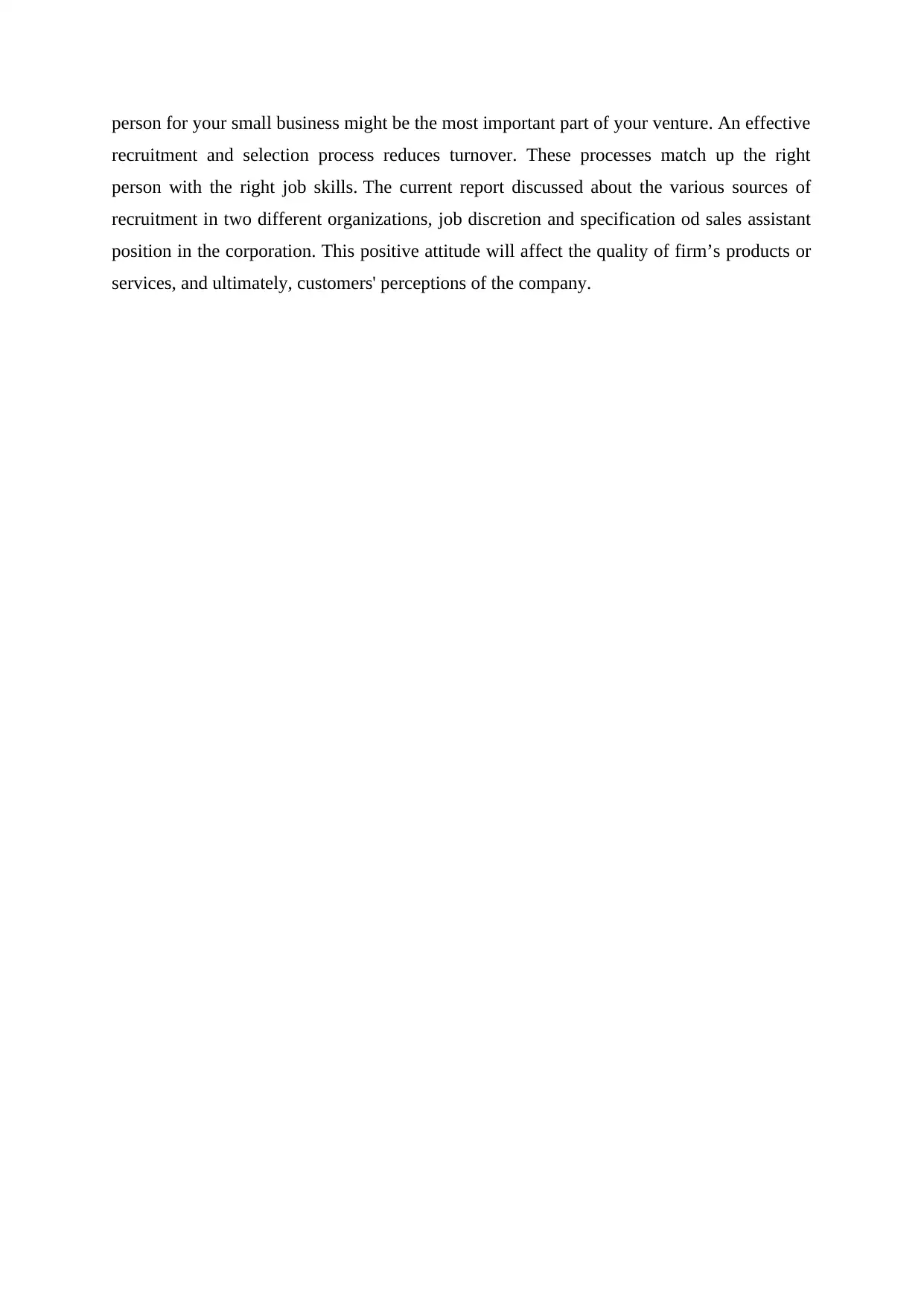
person for your small business might be the most important part of your venture. An effective
recruitment and selection process reduces turnover. These processes match up the right
person with the right job skills. The current report discussed about the various sources of
recruitment in two different organizations, job discretion and specification od sales assistant
position in the corporation. This positive attitude will affect the quality of firm’s products or
services, and ultimately, customers' perceptions of the company.
recruitment and selection process reduces turnover. These processes match up the right
person with the right job skills. The current report discussed about the various sources of
recruitment in two different organizations, job discretion and specification od sales assistant
position in the corporation. This positive attitude will affect the quality of firm’s products or
services, and ultimately, customers' perceptions of the company.
⊘ This is a preview!⊘
Do you want full access?
Subscribe today to unlock all pages.

Trusted by 1+ million students worldwide
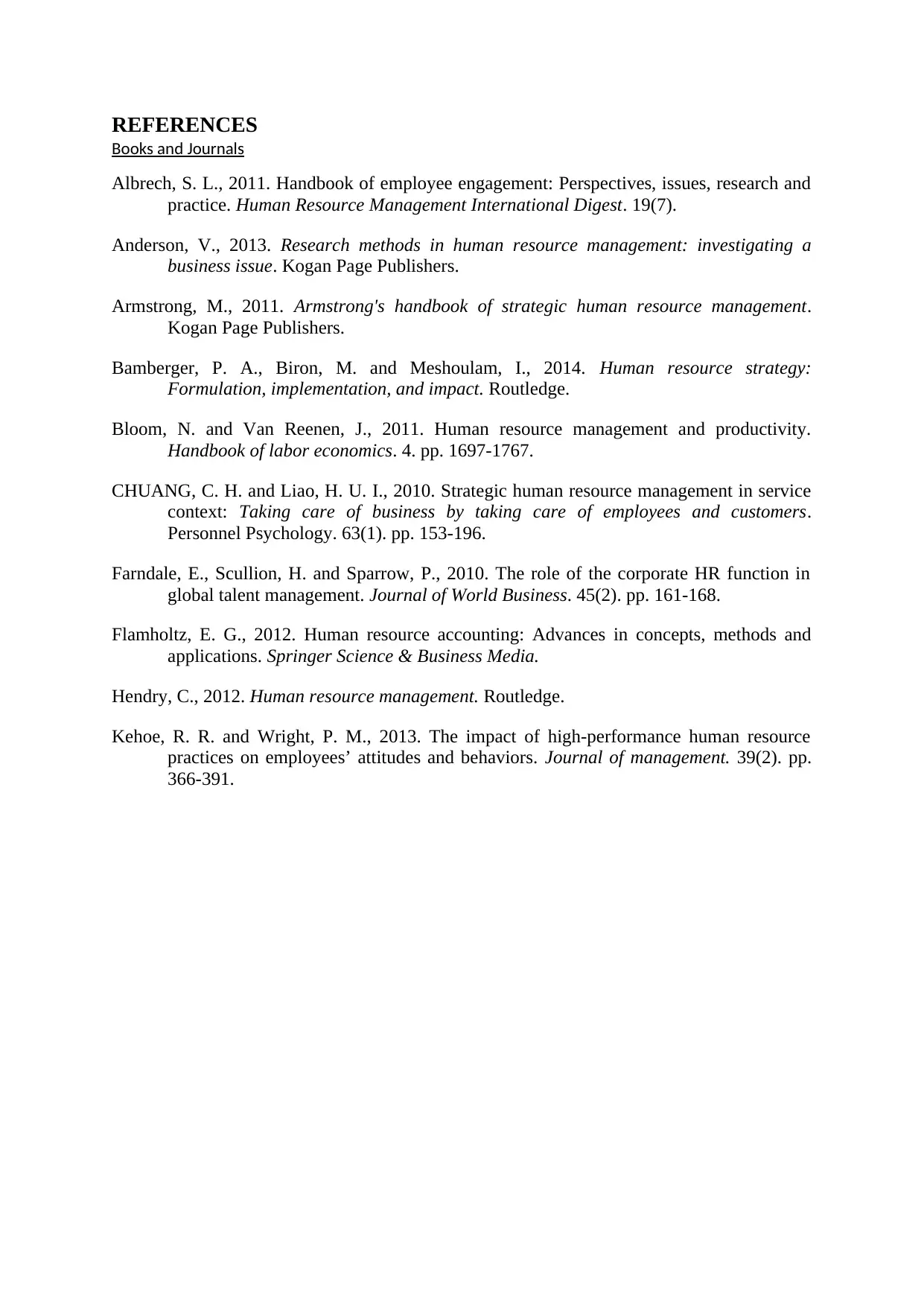
REFERENCES
Books and Journals
Albrech, S. L., 2011. Handbook of employee engagement: Perspectives, issues, research and
practice. Human Resource Management International Digest. 19(7).
Anderson, V., 2013. Research methods in human resource management: investigating a
business issue. Kogan Page Publishers.
Armstrong, M., 2011. Armstrong's handbook of strategic human resource management.
Kogan Page Publishers.
Bamberger, P. A., Biron, M. and Meshoulam, I., 2014. Human resource strategy:
Formulation, implementation, and impact. Routledge.
Bloom, N. and Van Reenen, J., 2011. Human resource management and productivity.
Handbook of labor economics. 4. pp. 1697-1767.
CHUANG, C. H. and Liao, H. U. I., 2010. Strategic human resource management in service
context: Taking care of business by taking care of employees and customers.
Personnel Psychology. 63(1). pp. 153-196.
Farndale, E., Scullion, H. and Sparrow, P., 2010. The role of the corporate HR function in
global talent management. Journal of World Business. 45(2). pp. 161-168.
Flamholtz, E. G., 2012. Human resource accounting: Advances in concepts, methods and
applications. Springer Science & Business Media.
Hendry, C., 2012. Human resource management. Routledge.
Kehoe, R. R. and Wright, P. M., 2013. The impact of high-performance human resource
practices on employees’ attitudes and behaviors. Journal of management. 39(2). pp.
366-391.
Books and Journals
Albrech, S. L., 2011. Handbook of employee engagement: Perspectives, issues, research and
practice. Human Resource Management International Digest. 19(7).
Anderson, V., 2013. Research methods in human resource management: investigating a
business issue. Kogan Page Publishers.
Armstrong, M., 2011. Armstrong's handbook of strategic human resource management.
Kogan Page Publishers.
Bamberger, P. A., Biron, M. and Meshoulam, I., 2014. Human resource strategy:
Formulation, implementation, and impact. Routledge.
Bloom, N. and Van Reenen, J., 2011. Human resource management and productivity.
Handbook of labor economics. 4. pp. 1697-1767.
CHUANG, C. H. and Liao, H. U. I., 2010. Strategic human resource management in service
context: Taking care of business by taking care of employees and customers.
Personnel Psychology. 63(1). pp. 153-196.
Farndale, E., Scullion, H. and Sparrow, P., 2010. The role of the corporate HR function in
global talent management. Journal of World Business. 45(2). pp. 161-168.
Flamholtz, E. G., 2012. Human resource accounting: Advances in concepts, methods and
applications. Springer Science & Business Media.
Hendry, C., 2012. Human resource management. Routledge.
Kehoe, R. R. and Wright, P. M., 2013. The impact of high-performance human resource
practices on employees’ attitudes and behaviors. Journal of management. 39(2). pp.
366-391.
1 out of 10
Related Documents
Your All-in-One AI-Powered Toolkit for Academic Success.
+13062052269
info@desklib.com
Available 24*7 on WhatsApp / Email
![[object Object]](/_next/static/media/star-bottom.7253800d.svg)
Unlock your academic potential
Copyright © 2020–2025 A2Z Services. All Rights Reserved. Developed and managed by ZUCOL.





